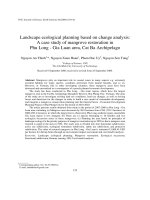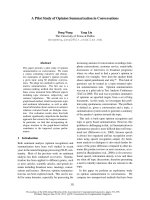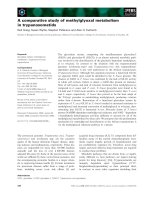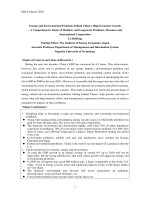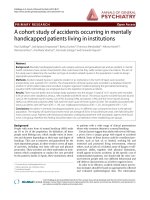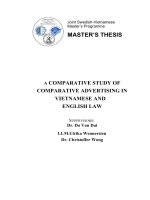A comprehensive study of esterification and hydrolysis of methyl acetate in simulated moving bed systems
Bạn đang xem bản rút gọn của tài liệu. Xem và tải ngay bản đầy đủ của tài liệu tại đây (2.13 MB, 261 trang )
A COMPREHENSIVE STUDY OF ESTERIFICATION
AND HYDROLYSIS OF METHYL ACETATE
IN SIMULATED MOVING BED SYSTEMS
YU WEIFANG
NATIONAL UNIVERSITY OF SINGAPORE
2003
A COMPREHENSIVE STUDY OF ESTERIFICATION
AND HYDROLYSIS OF METHYL ACETATE
IN SIMULATED MOVING BED SYSTEMS
YU WEIFANG
(B. Eng., Zhejiang University, China)
A THESIS SUBMITTED
FOR THE DEGREE OF DOCTOR OF PHILOSOPHY
DEPARTMENT OF CHEMICAL&ENVIRONMENTAL ENGINEERING
NATIONAL UNIVERSITY OF SINGAPORE
2003
i
Acknowledgements
With pleasure and gratitude I wish to express my appreciation to my research
advisors, Prof. Ajay Kumar Ray and Prof. Kus Hidajat, for their enthusiasm,
encouragement, insight, suggestions and support throughout the course of this research
project.
I am always grateful to Prof. Massimo Morbidelli, the department of chemistry,
ETH, Zurich, for his encouragement and invaluable advices and suggestions. Thanks
also to the graduate students in his research group, who made my stay in ETH very
enjoyable.
I am also thankful to Prof. Marc Garland and Prof. Sibudjing Kawi, the
members of my Ph.D. committee, for rendering me suggestions and guidance. I wish to
express my gratitude to Mdm. Chiang, Miss Ng, Mdm. Jamie, Mdm. Li Xiang, Mr.
Boey, Mr. Mao Ning and the SVU team for their help with my experimental and
computational work. I thank all my lab-mates and all my friends both in Singapore and
abroad, who have enriched my life personally and professionally. The Research
Scholarship from the National University of Singapore is also gratefully
acknowledged.
I cannot find any words to thank my husband, Xu Jin, for his love,
encouragement, patience, help and support through the years of my graduate study.
Finally, to my parents goes my eternal gratitude for their boundless love, support and
dedication.
ii
Table of Contents
Acknowledgements i
Table of Contents ii
Summary viii
List of Tables x
List of Figures xiii
Nomenclatures xviii
Chapter 1 Introduction 1
Chapter 2 Literature Review 9
2.1 Introduction to Chromatography 9
2.2 Batch Chromatographic Reactor 10
2.3 Continuous Chromatographic Reactor 13
2.3.1 Annular Rotating Chromatographic Reactor 14
2.3.2 Countercurrent Chromatographic Reactor 15
2.3.2.1 True Countercurrent Moving Bed Reactor 15
2.3.2.2 Simulated Countercurrent Moving Bed Reactor 22
2.4 Design and Optimization Strategy for the Simulated Moving
Bed Systems 38
2.4.1 Design Criteria Proposed by the Research Group at
University of Minnesota 38
2.4.2 Triangle Theory Proposed by the Research Group at
ETH, Zurich 40
2.4.2.1 Linear Isotherm 42
2.4.2.2 Nonlinear Isotherm 44
iii
2.4.3 Standing Wave Proposed by the Research Group at
Purdue University 47
2.4.3.1 Linear System without Axial Dispersion and
Mass Transfer Resistance 49
2.4.3.2 Linear System with Axial Dispersion and Mass
Transfer Resistance 51
Chapter 3 Reaction Kinetics and Adsorption Isotherm Studies for
Methyl Acetate Esterification and Hydrolysis 54
3.1 Introduction 54
3.2 Reaction Kinetics and Adsorption Isotherm 55
3.3 Estimation of Reaction and Adsorption Parameters 58
3.3.1 Experimental Details 58
3.3.2 Experimental Procedure 60
3.3.3 Development of Mathematical Model 61
3.3.4 Parameter Estimation from Breakthrough Curves 63
3.4 Results and Discussion 64
3.4.1 Synthesis of Methyl Acetate 64
3.4.1.1 Determination of Adsorption and Kinetic
Parameters 64
3.4.1.2 Estimation of Bulk (External) Diffusion
Resistance 70
3.4.1.3 Estimation of Pore Diffusion Resistance 71
3.4.1.4 Effect of Temperature on the Adsorption and
Kinetic Parameters 75
3.4.2 Hydrolysis of Methyl Acetate 76
iv
3.4.2.1 Determination of Adsorption and Kinetic
Parameters 76
3.4.2.2 Effect of Temperature on the Adsorption and
Kinetic Parameters 83
3.4.3 Comparison of the Adsorption and Kinetic Parameters
with those Reported in Literature 84
3.5 Conclusions 88
Chapter 4 Optimization of SMBR for MeOAc Synthesis 90
4.1 Introduction 90
4.2 Mathematical Modeling of SMBR 96
4.3 Optimization of SMBR 98
4.3.1 Definition of the Objective Functions 98
4.3.2 Complete Conversion and Separation Region 99
4.3.3 Case 1: Maximization of Productivity and Purity of
Methyl Acetate 100
4.3.3.1 Case 1a: Optimal Column Distribution 101
4.3.3.2 Case 1b: Optimal Feed Composition 105
4.3.3.3 Case 1c: Effect of Constraint on Conversion 108
4.3.3.4 Case 1d: Effect of Reaction Rate Constants 109
4.3.4 Case 2: Maximization of Productivity & Minimization
of Desorbent Requirement 113
4.3.5 Case 3: Maximization of Productivity & Purity with
Minimization of Desorbent Requirement 117
4.6 Conclusions 119
Chapter 5 Modeling, Simulation and Experimental Study of SMBR
for MeOAc Synthesis 120
v
5.1 Introduction 120
5.2 Synthesis of MeOAc in SMBR 120
5.3 Mathematical Model 123
5.4 Experimental Details 129
5.5 Results and Discussion 133
5.5.1 Effect of Switching Time 133
5.5.2 Effect of Desorbent Flow Rate 139
5.5.3 Effect of Feed Flow Rate 142
5.5.4 Effect of Flow Rate in Section P 146
5.6 Sensitivity Study 149
5.7 Conclusions 153
Chapter 6 Optimization of Reactive SMB & Varicol Process for
MeOAc Synthesis 155
6.1 Introduction 155
6.2 SMBR and Reactive Varicol Systems 158
6.3 Mathematical Model 161
6.4 Optimization of SMBR and Reactive Varicol Systems 162
6.5 Case1: Existing Set-up: Maximization of Purity and Yield of
Methyl Acetate 164
6.5.1 Effect of Distributed Feed 169
6.6 Case 2: Design-stage Optimization: Maximization of Purity
of MeOAc and Minimization of Volume of Solid 174
6.6.1 Effect of Feed Flow Rate, α 175
6.6.2 Effect of Raffinate Flow Rate, β 177
6.6.3 Effect of Flow Rate in Section P, Q
P
177
6.6.4 Effect of Total Number of Columns, N
col
177
vi
6.7 Case 3: Design Stage Optimization: Minimization of Volume
of Solid and Desorbent Consumption 178
6.8 Case 4: Maximization of Purity and Yield of MeOAc and
Minimization of Desorbent Consumption 181
6.9 Conclusions 183
Chapter 7 Optimization of Reactive SMB & Varicol Processes for
MeOAc Hydrolysis 184
7.1 Introduction 184
7.2 Mathematical model 185
7.3 Sensitivity Study 187
7.4 Optimization of SMBR and Varicol 188
7.4.1 Case1: Maximization of Purity of Both Raffinate and
Extract Streams 188
7.4.1.1 Effect of the Column Length, L
col
196
7.4.1.2 Effect of Raffinate Flow Rate, β 196
7.4.1.3 Effect of Eluent Flow Rate, γ 199
7.4.1.4 Effect of Distributed Feed Flow 201
7.4.1.5 Comparison of the Performance of SMBR and
Reactive Varicol Systems 205
7.4.1.6 Effect of Number of Sub-interval 207
7.4.2 Case 2: Maximization of Y
HOAc
in Raffinate Stream
and Y
MeOH
in Extract Stream 208
7.5 Conclusions 213
Chapter 8 Conclusions & Recommendations 214
8.1 Conclusions 214
vii
8.1.1 Reaction Kinetics and Adsorption Isotherm Studies for
Methyl Acetate Esterification and Hydrolysis 214
8.1.2 Optimization of SMBR for MeOAc Synthesis 216
8.1.3 Modeling, Simulation and Experimental Study of
SMBR for MeOAc Synthesis 217
8.1.4 Optimization of Reactive SMB & Varicol for MeOAc
Synthesis 218
8.1.5 Optimization of Reactive SMB & Varicol for MeOAc
Hydrolysis 218
8.2 Recommendations for Future Work 219
REFERENCES 220
Publications 232
Appendix A A note on Genetic Algorithm 233
Appendix B Experimental Data for MeOAc Synthesis in the SMBR 237
viii
Summary
The simulated moving bed reactor (SMBR) in which chemical reaction and
chromatographic separation take place concurrently is gaining significant attention in
recent years. The coupling of two unit operations in SMBR may reduce the capital and
operating costs of the process and enhance the conversion of equilibrium-limited
reactions. Several studies show that substantial improvements in the process
performance could be achieved in SMBR compared to fixed bed operation, and its
application to some fine chemical and pharmaceutical industry is promising. However,
due to the complexity of SMBR process, there is very few application of SMBR in the
chemical industry. A more detailed understanding and criteria for the design and
operating of SMBR are needed before successful implementation on industrial scale
can be achieved.
In this research work, the reversible reaction of acetic acid and methanol
catalyzed by Amberlyst 15 ion exchange resin was considered. The performance of
SMBR was studied theoretically and experimentally for deeper insight into the
behavior of the process. A new optimization and design strategy, multi-objective
optimization, was proposed to improve the performance of SMBR and its modification,
reactive Varicol, which adopts the non-synchronous shift of the inlet and outlet ports
instead of the synchronous one used in SMBR, for the model reaction system.
The adsorption equilibrium constants, dispersion coefficients and kinetic
parameters were first determined for the synthesis and hydrolysis of methyl acetate,
corresponding to the different mobile phases, methanol or water. They were
determined semi-empirically by fitting the experimentally measured breakthrough
curves with the predictions from the single column chromatographic reactor model,
which was developed based on equilibrium-dispersive model, quasi-homogeneous
reaction kinetics and linear adsorption isotherm. Thereafter, The single column
ix
chromatographic reactor model was extended to describe the behavior of SMBR unit
by imposing the outlet concentration of one column as the inlet condition for the next
column downstream, while incorporating the cyclic port switching and additional feed
or withdrawal streams. The SMBR model predicted results for the synthesis of methyl
acetate were verified experimentally at different operating conditions, and parametric
analysis was carried out based on the verified model to systematically investigate the
effects of process parameters on the performance of SMBR. The experimental as well
as theoretical results clearly demonstrate that it is possible to obtain improved
conversion and product purity for methyl acetate synthesis in SMBR, and it also
reveals that there is a complex interplay of the operating parameters on the reactor
performance. Some of the parameters act in conflicting ways. When one objective
function is improved, the other is worsened.
Therefore, comprehensive multi-objective optimization study was performed
for the synthesis and hydrolysis of methyl acetate using the experimentally verified
model developed in this study to determine appropriate design and operating
conditions for successful implementation of SMBR on industrial scale. The
optimization problems were formulated both for the performance enhancement of an
existing unit and the optimal design of a new plant. A robust, non-traditional global
optimization technique known as Non-dominated Sorting Genetic Algorithm (NSGA)
was used in obtaining the optimal solutions. The applicability of Varicol to reaction
system was also investigated. It was found that reactive Varicol performs better than
SMBR due to its increased flexibility in column distribution.
x
List of Tables
Table 2.1 Detailed description of the various investigations on CMCR 18
Table 2.2 Detailed description of the various Investigations on SMBR 25
Table 3.1 Typical Properties of Amberlyst 15 Dry Ion Exchange Resin 59
Table 3.2 Adsorption equilibrium constants and apparent dispersion
coefficients for MeOAc and H
2
O (methanol as mobile phase) 66
Table 3.3 Adsorption equilibrium constant, K
As
and kinetic parameters,
k
fs
and K
es
for the synthesis of MeOAc (methanol as mobile
phase) 68
Table 3.4 Heat of adsorption, heat of reaction, activation energy and
other thermodynamic values for the synthesis of MeOAc
(methanol as mobile phase)
75
Table 3.5 Adsorption equilibrium constants and apparent dispersion
coefficients for HOAc and MeOH (water as mobile phase) 76
Table 3.6 Adsorption equilibrium constant, K
Eh
, and kinetic parameters,
k
fh
and K
eh
for the hydrolysis of methyl acetate (water as
mobile phase) 79
Table 3.7 Heat of adsorption, heat of reaction, activation energy and
other thermodynamic values for the hydrolysis of MeOAc
(water as mobile phase) 83
Table 3.8 Comparison of the computed adsorption equilibrium constants
reported in literature with those obtained in this work at T =
313 K
84
Table 4.1 Comparison of the performance of a 5-column SMBR 100
Table 4.2 Formulation of the optimization problem solved in Case 1 101
Table 4.3 Kinetic and adsorption parameters used in the optimization 102
xi
problems
Table 4.4 Optimal flow rate ratios (m
2
, m
3
) for different acetic acid mole
fraction in the feed
106
Table 4.5 Optimal flow rate ratios (m
2
, m
3
) for different conversion
constraints
109
Table 4.6 Optimal flow rate ratios (m
2
, m
3
) for different values of
reaction rate constant 111
Table 4.7 Formulation of the optimization problem solved in Case 2 and
Case 3 113
Table 5.1
Comparison of σ and V (cm/min) of the two components in
different sections for various operating conditions
137
Table 5.2 Sensitivities of process parameters for the synthesis of MeOAc 150
Table 6.1 Description of the multiobjective optimization problems
solved together constraints, bounds of decision variables, and
fixed parameters 165
Table 6.2 Comparison of optimal predictions with experimental results 169
Table 6.3 Comparison of objective function values for constant and
variable feed flow rate 171
Table 6.4 Possible column configuration (distribution) for N
col
= 5 and 6 180
Table 7.1 Sensitivities of process parameters for the hydrolysis of
MeOAc 190
Table 7.2 Description of the multiobjective optimization problems
solved together with constraints, bounds of decision variables,
and fixed parameters 192
Table 7.3 Comparison of objective function values for constant and
variable feed flow 202
xii
Table 7.4 List of possible optimal column configurations for 6 and 7-
column Varicol within a global switching period 207
Table B.1 Effect of switching time 236
Table B.2 Effect of eluent flow rate 236
Table B.3 Effect of feed flow rate 237
Table B.4 Effect of flow rate in section P 237
xiii
List of Figures
Figure 2.1 Operating principle of the batch chromatographic reactor
(Fricke et al. 1999b)
11
Figure 2.2 Schematic diagram of the rotating annulus reactor (Carr,
1993)
14
Figure 2.3 Typical configuration of a CMCR 17
Figure 2.4 Comparison of 6-column SMB and 4-subinterval Varicol 24
Figure 2.5 Triangle Theory: Regions of (m
2
, m
3
) plane with different
separation regimes in terms of purity of the outlet streams
(Storti et al., 1993; Mazzotti et al., 1996a; 1997a)
43
Figure 2.6 Standing Wave in a linear TMB system (Wu et al., 1999) 48
Figure 3.1 Effect of temperature on breakthrough curve of the MeOAc-
H
2
O system
65
Figure 3.2 Effect of feed concentration on breakthrough curve of the
MeOAc-H
2
O system
67
Figure 3.3 Effect of temperature on breakthrough curve of the HOAc-
MeOAc-H
2
O system
69
Figure 3.4 Effect of particle size on the reaction kinetics of synthesis
and hydrolysis of MeOAc
71
Figure 3.5 Effect of feed concentration on breakthrough curve of the
HOAc-MeOAc-H
2
O system
73
Figure 3.6 Effect of flow rate on breakthrough curve of the HOAc-
MeOAc-H
2
O system
74
Figure 3.7 Effect of temperature on breakthrough curve of the HOAc 77
Figure 3.8 Effect of temperature on breakthrough curve of MeOH 78
xiv
Figure 3.9 Effect of temperature on breakthrough curve of the MeOAc-
HOAc-MeOH system
80
Figure 3.10 Effect of feed concentration on breakthrough curve of the
MeOAc-HOAc-MeOH system
81
Figure 3.11 Effect of flow rate on breakthrough curve of the MeOAc-
HOAc-MeOH system
82
Figure 3.12 Comparison of model predicted results with experimental
results for non-reactive breakthrough curves of (a) E and (b)
W
86
Figure 3.13 Comparison of experimental results of HOAc concentration
profile reported by Pöpken et al. (2000) with our
experimental and model predicted results in a batch reactor
87
Figure 4.1 Schematic diagram of a true countercurrent moving bed
reactor
91
Figure 4.2 Schematic flow diagram of a SMBR unit 93
Figure 4.3 Optimal column distribution 104
Figure 4.4 Optimal feed composition 107
Figure 4.5 Comparison of Paretos for different acetic acid feed mole
fractions
108
Figure 4.6 Effect of conversion constraint on Paretos and corresponding
decision variables
109
Figure 4.7 Effect of reaction rate on the Paretos for maximization of
productivity and purity
112
Figure 4.8 Periodical steady state concentration profiles of A, M, E and
W at the end of a switching cycle
112
Figure 4.9 Maximum productivity and minimum desorbent requirement 115
xv
Figure 4.10 Effect of m
1
on the Pareto optimal solutions 116
Figure 4.11 Maximization of productivity and purity together with
minimization of desorbent requirement
118
Figure 5.1 Schematic diagram of a SMBR system for MeOAc synthesis 122
Figure 5.2 Schematic diagram of a 4-column experimental apparatus 132
Figure 5.3 Effect of switching time on the performance of SMBR 134
Figure 5.4 Effect of switching time on the cyclic steady state
concentration profiles of MeOAc-H
2
O-HOAc
138
Figure 5.5 Effect of eluent flow rate on the performance of SMBR 141
Figure 5.6 Effect of eluent flow rate on the cyclic steady state
concentration profiles of MeOAc-H
2
O-HOAc
141
Figure 5.7 Effect of feed flow rate on the performance of SMBR 144
Figure 5.8 Effect of feed flow rate on the cyclic steady state
concentration profiles of MeOAc-H
2
O-HOAc
145
Figure 5.9 Effect of flow rate in section P on the performance of SMBR 147
Figure 5.10 Effect of flow rate in section P on the cyclic steady state
concentration profiles of MeOAc-H
2
O-HOAc
148
Figure 6.1 Comparison of SMBR and Varicol processes 160
Figure 6.2 Optimal solutions and corresponding operating variables for
maximization of purity and yield of MeOAc
167
Figure 6.3 Concentration profiles of MeOAc-H
2
O-HOAc at the end of
100 switching
168
Figure 6.4 Comparison of optimal results for constant and variable feed
flow rates
171
Figure 6.5 Concentration profiles for constant and variable feed at the
end of each sub-time interval
173
xvi
Figure 6.6 Pareto optimal solutions and corresponding values of
decision variables for maximum P
MeOAc
and minimum V
solid
174
Figure 6.7 Effect of (a) α, (b) β, (c) Q
p
and (d) N
col
on the Pareto optimal
solutions
176
Figure 6.8 Optimal solutions for minimization of adsorbent volume and
eluent consumption and corresponding decision variables
179
Figure 6.9 Comparison of Pareto optimal solution between SMBR and
Varicol
182
Figure 7.1 Optimal solutions and corresponding decision variables for
maximization of P
HOAc
in raffinate and P
MeOH
in extract
195
Figure 7.2 Concentration profiles of MeOAc-HOAc-MeOH at the end of
100 switching
197
Figure 7.3 Comparison of Pareto solutions for different length of
column
198
Figure 7.4 Effect of raffinate flow rate on the optimal solutions 198
Figure 7.5 Effect of desorbent flow rate on the optimal solutions 199
Figure 7.6 Concentration profiles of MeOAc-HOAc-MeOH at the end of
100 switching
200
Figure 7.7 Comparison of optimal solutions of constant and distributed
feed flow
202
Figure 7.8 Concentration profiles for constant and variable feed at the
end of each sub-time intervals
204
Figure 7.9 Comparison of Paretos for 6, 7-column Varicol and 7, 8-
column SMBR
206
Figure 7.10 Effect of number of subinterval for 7-column Varicol 208
Figure 7.11 Pareto solutions and corresponding decision variables for 210
xvii
maximization of Y
HOAc
in raffinate and Y
MeOH
in extract
Figure 7.12 Concentration profile of MeOAc-HOAc-MeOH system at the
end of 100 switching
211
Figure 7.13 Comparison of optimal solutions of 7-column Varicol and an
equivalent SMBR for Case 2
212
Figure A.1 A flowchart describing NSGA (Bhaskar et al., 2000a)
235
xviii
Nomenclatures
A acetic acid
C concentration in liquid phase
d diameter
D apparent axial dispersion coefficient; desorbent
E methyl acetate; activation energy
F error (objective) function
∆G
change in Gibbs free energy of reaction
H height equivalent of a theoretical plate
HOAc acetic acid
∆H
heat of adsorption
k reaction rate constant, mass transfer coefficient
K reaction equilibrium constant; adsorption constant; Langmuir
parameter
L length
m flow rate ratio parameter
M methanol
MeOAc methyl acetate
MeOH methanol
n mole number; order of reaction
N plate number; sorption capacity; number of switching; total
number of columns
p number of columns in section P
P purity; section P
PrE productivity of MeOAc at the raffinate port
PurE purity of MeOAc at the raffinate port
xix
PurW purity of water at the extract port
Q volumetric flow rate; section Q
q concentration in polymer phase; swelling ratio; number of
columns in section Q
r number of columns in section R
R reaction rate; resin particle radius; section R
s number of columns in section S
S section S, selectivity
t time
T temperature
∆S
entropy change
u superficial fluid phase flow rate
V volume; velocity
W water; weight
x vector of fitted parameters; mole fraction
X conversion
Y yield
z axial coordinate
Greek Symbols
α
fraction of feed
β fraction of raffinate
χ
column configuration, dimensionless length
ε void fraction
δ
phase ratio
φ
section
γ fraction of desorbent
xx
ζ
pseudo solid phase velocity
ν
stoichiometric coefficient of component
σ
relative carrying capacity
ρ
density of polymer resin
Subscripts and Superscripts
A acetic acid
ap apparent
b backward
col column
D desorbent stream
e equilibrium
E methyl acetate; eluent
Ex extract stream
exp experiment
f feed, forward
F feed stream
g gas, carrier
h hydrolysis
HOAc acetic acid
i component i
j jth data point; jth application; section j
k M or W (mobile phase)
L liquid phase
m model; number of data points; mass transfer
M methanol
MeOAc methyl acetate
xxi
N number, switching period
o initial; standard; inlet
p width of rectangular pulse; section P
P polymer phase
q section Q
r section R
Ra raffinate stream
s synthesis; switching; section S; solid
w water
Chapter 1 Introduction
1
Chapter 1 Introduction
Since separation process is indispensable for nearly every chemical
manufacturing operation in order to obtain desired high purity products, integration of
chemical reaction and separation into one single unit may significantly improve the
economics and efficiency of process industries. Compared with the traditional process
design of reaction and separation in series, the coupling of the two unit operations in
one apparatus leads to lower capital investment and energy costs. Moreover, for
reversible reactions, conversion can be enhanced beyond thermodynamic equilibrium
by in-situ separation of the products resulting in better yield and selectivity.
The advantages of combining chemical reaction and separation have been
exploited for a long time in the petrochemical industry with reactive distillation
processes, and reactive distillation has now become the process of choice for a number
of industry applications. However, one drawback of reactive distillation is that it is not
applicable to the reaction system where the components involved are non-volatile or
heat-sensitive, as this is the case in some fine chemical and pharmaceutical
applications. An alternative integrated process for producing high purity products is
chromatographic reactor, which couples chemical reaction with chromatographic
separation. The driving force for chromatographic separation is the differences in
adsorption affinity of the different components involved on the stationary phase. The
utilization of chromatographic processes in reaction system is competitive to the use of
other separation processes, such as membranes, extraction or crystallization, due to its
superior separating power, versatility, relatively low cost and mild operating
conditions. Additionally, if a chromatographic separation had been used for
purification of the products before, lengthy work for screening a suitable adsorbent is
omitted (Fricke et al., 1999a). Only the catalyst has to be chosen before the design of
Chapter 1 Introduction
2
the process. Consequently, the cost of process development is significantly reduced.
Furthermore, chromatographic reactor seems especially attractive due to its potential
applicability to life science products, which are considered to be the most promising
market for the near future.
Since it was developed in the early 1960’s, chromatographic reactor has been
used for analytical purposes as well as for preparative applications in either batch or
continuous operation. In the recent years, more attention has been focused on the
continuous mode, which offers advantages of high efficiency in utilizing the stationary
phase inventory and small amount of eluent consumption over the batch mode.
Perhaps, the simplest way to realize an efficient continuous process would be a
countercurrent flow of solid and fluid phase (true countercurrent moving bed reactor),
which maximizes the average driving force. Both theoretical and experimental
investigations have been carried out on the performance of true countercurrent moving
bed chromatographic reactor (Viswanathan and Aris, 1974a, 1974b; Takeuchi and
Uraguchi, 1976a, 1976b, 1977, 1979; Cho et al., 1982; Song and Lee, 1982; Petroulas
et al., 1985a, 1985b; Fish et al., 1986, 1988, 1989). The conversion of reversible
reaction much greater than equilibrium with high product purity was reported in these
studies.
However, the actual movement of the solid phase in a true countercurrent
moving bed chromatographic reactor causes a number of problems when scaling up to
a large column diameter, such as mechanical difficulties of moving the solid, adsorbent
attrition, fines removal, expansions of the bed, channeling in the reactor etc. In order to
circumvent the problems associated with the handling of solids, the simulated moving
bed technology (SMB), introduced by UOP in 1960s (Broughton and Gerhold, 1961) is
used as a promising approach. In SMB technology, the countercurrent movement of the
fluid phase toward the solid phase is mimicked by switching the introduction and

